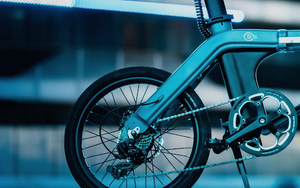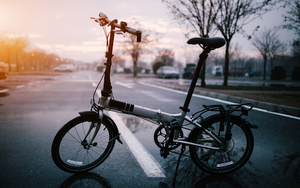Are Electric Scooters Waterproof? Expert Advice
Nov 13, 2023
Electric scooters have become increasingly popular as a convenient and eco-friendly mode of transportation. Whether you're commuting to work or enjoying a leisurely ride, you may be wondering if electric scooters are waterproof. In this article, we will delve into the design, concept of waterproofing, factors affecting waterproofing, manufacturer claims vs reality, and the risks and consequences of water damage.
Understanding Electric Scooter Design
Before we examine the waterproof capabilities of electric scooters, it's essential to understand their design. Electric scooters are comprised of various components that work together to provide a smooth and efficient ride.
Electric scooters have become increasingly popular in recent years as a convenient and eco-friendly mode of transportation. They offer a practical solution for short commutes and are often favoured by urban dwellers looking for an alternative to cars or public transportation.
Now, let's delve into the key components that make up an electric scooter and understand their individual roles in ensuring a seamless riding experience.
Key Components of an Electric Scooter

Electric scooters consist of a motor, battery, controller, throttle, brakes, and tyres. Each component plays a vital role in the scooter's overall performance and, to some extent, its water resistance.
Motor
The motor is the heart of an electric scooter. It converts electrical energy from the battery into mechanical energy, propelling the scooter forward. The power and efficiency of the motor determine the scooter's speed and acceleration capabilities.
Battery
The battery, on the other hand, serves as the energy source for the motor. It stores and provides the electrical energy needed to power the scooter. The capacity and quality of the battery directly impact the scooter's range and overall performance.
Controller
The controller acts as the brain of the electric scooter, regulating the flow of electricity from the battery to the motor. It ensures smooth acceleration, deceleration, and efficient energy management. A well-designed controller can significantly enhance the scooter's performance and responsiveness.
Throttle
The throttle is the control mechanism that allows the rider to adjust the speed of the scooter. It is usually located on the handlebars and can be operated with a twist grip or a thumb lever. The throttle is directly connected to the controller and provides input for the desired speed.
Brakes
Brakes are crucial for the safety of the rider and play a vital role in controlling the scooter's speed and bringing it to a stop. Electric scooters typically have disc brakes or drum brakes, which are activated by hand levers or foot pedals. The effectiveness and responsiveness of the brakes are essential for a rider's confidence and overall riding experience.
Tyres
Tyres are another critical component of an electric scooter. They provide traction, stability, and shock absorption. The type of tires used can vary depending on the scooter's intended use and terrain. Some scooters have solid rubber tires, while others feature air-filled pneumatic tires for a smoother ride. For example, the Ducati Scrambler Cross-E electric scooter has the perfect tyres for dirt tracks and off-roading.

The Role of Water Resistance in Electric Scooters
Water resistance is an important consideration for electric scooters, especially if you plan to ride in wet conditions or encounter unexpected rain showers. Adequate water resistance ensures that the scooter's critical components are protected from moisture, preventing potential damage.
Look Out For Extra Features
Manufacturers employ various techniques to enhance the water resistance of electric scooters. One common method is to use waterproof seals and gaskets to protect the internal components from water ingress. Additionally, some scooters feature water-resistant coatings on the electronic circuitry to provide an extra layer of protection. The Ienyrid M4 Pro Electric Scooter has a IP54 waterproof rating making it great for all weather conditions.
Full Waterproofing Isn’t Guaranteed
It's worth noting that while electric scooters are designed to withstand light rain and splashes, they are not fully waterproof. Submerging an electric scooter in water or exposing it to heavy rain can cause significant damage to the electrical components and compromise the scooter's functionality.
Take Precautions in Wet Weather
When riding an electric scooter in wet conditions, it's essential to take precautions such as avoiding deep puddles, drying the scooter thoroughly after exposure to moisture, and storing it in a dry place. Regular maintenance, including checking and tightening any loose connections, can also help ensure the scooter's longevity and water resistance.
In conclusion, understanding the design and key components of electric scooters is crucial for comprehending their water resistance capabilities. By considering the role of each component and taking appropriate precautions, riders can enjoy a reliable and safe riding experience, even in less-than-ideal weather conditions.

The Concept of Waterproofing in Electric Scooters
When we talk about waterproofing, it's crucial to understand the difference between being waterproof and water-resistant.
Defining Waterproof and Water-Resistant
Waterproof refers to an object's ability to resist water penetration entirely, while water-resistant means it can withstand exposure to water to some degree, without being completely impervious to it.
How Waterproofing Works in Electric Scooters
Manufacturers employ different techniques to enhance the waterproofing capabilities of electric scooters. Key areas that typically receive attention include the battery compartment, motor housing, and control panel. By utilising specialised seals, gaskets, and coatings, manufacturers aim to protect these vulnerable areas from water intrusion.
It's important to note that while manufacturers may claim their scooters are waterproof, it's vital to understand the limitations of such claims and how they translate into real-world performance.
Factors Affecting the Waterproofing of Electric Scooters
Several factors can influence the overall waterproofing of an electric scooter. These factors include the materials used in construction and the level of maintenance and care provided.
Material and Construction
The choice of materials in constructing an electric scooter, such as the frame, housing, and connectors, contributes to its water resistance. Components made from corrosion-resistant materials, like stainless steel and high-quality plastics, can significantly improve the scooter's ability to withstand moisture.
Maintenance and Care
Regular maintenance and proper care can also impact the waterproofing of electric scooters. Timely inspections, cleaning, and application of protective coatings can help maintain the scooter's water resistance and extend its lifespan.

Manufacturer Claims vs Reality
When considering the waterproofing capabilities of electric scooters, it is essential to be aware of manufacturer claims and how they align with real-world scenarios.
Interpreting Manufacturer Specifications
Manufacturers often provide specifications regarding the level of waterproofing their electric scooters offer. However, it is crucial to interpret these claims with caution. Some manufacturers may use ambiguous terms or exaggerate the level of water resistance. It's advisable to look for specific water resistance ratings, such as IPX4 or IPX7, which provide a more accurate understanding of a scooter's capabilities.
IPX4 typically indicates protection against water splashes from any direction, while IPX7 signifies that the scooter can withstand immersion in up to 1 meter of water for a limited time.
The Truth about "Waterproof" Electric Scooters
While electric scooters may be advertised as waterproof, it is important to remember that they are not designed to be fully submerged in water for extended periods. Exposing the scooter to excessive water, such as riding through flooded roads or submerging it in water, can lead to severe damage to its electrical components.

Risks and Consequences of Water Damage
Understanding the potential risks and consequences of water damage can help scooter owners make informed decisions regarding usage and maintenance.
Potential Damage from Water Exposure
Exposure to water can cause a range of issues, such as corrosion, electrical shorts, and damage to the scooter's control systems. These problems may lead to reduced performance, increased maintenance costs, and even complete scooter failure.
Warranty and Insurance Considerations
It's important to review the manufacturer's warranty and insurance policies to determine the extent of coverage for water damage. Some warranties may exclude water-related incidents, while others may require regular maintenance or specific care guidelines to be followed.
Conclusion
While electric scooters may offer varying degrees of water resistance, it is essential to understand their limitations and take appropriate precautions. Regular maintenance, adherence to manufacturer guidelines, and avoiding excessive water exposure can help prolong the lifespan and performance of your electric scooter. Remember, being aware of the scooter's waterproofing capabilities and practising caution will ensure a safe and enjoyable riding experience.






